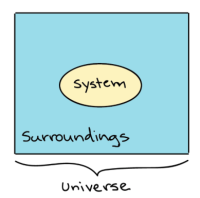How can we describe energy? Energy is a property that cannot be created or destroyed. It is also a mechanical work or heat in thermodynamic language. However, it is really difficult to describe what is energy in biological systems.
British physicist Lord Kelvin once said: “There is nothing new to be discovered in physics now. All that remains is more and more precise measurement.”
Thermodynamics is mainly a matter of discovering and then using the principles, or laws, that govern energy transformations and working out the relationship between those principles (1).
The First Law of Thermodynamics related heat, work and internal energy. It tells us that energy can neither be created nor destroyed, despite being able to change form; the total energy of a reaction, and indeed of the universe, is constant. The First Law tells us with breathtaking generality that a boundary on the possible is a basic characteristic of our universe (2).
The Second Law of Thermodynamics makes biological processes more interesting, including the Entropy of systems. This is the measure of the order of a system, in a way of describing how molecules are arranged in space, and how these molecules change when the system change temperature, pressure, volume, etc. It is a degree of disorder or randomness. The Second Law of Thermodynamics is a principle, which states that in any cyclic process the entropy will increase or remain the same. In every natural thermodynamic process the sum of the entropies of all participating bodies is increased. So the Second Law says that no natural process can occur unless it is accompanied by an increase in the entropy of the universe. Ultimately every process that occurs in nature is irreversible and unidirectional, with the direction being dictated by the requirement of an overall increase in entropy (3).
All living organisms are highly non-equilibrium systems. A system will exhibit net change if it is not at equilibrium, even if the rate of change is imperceptible...Continue reading
The post Thermodynamics and reproduction. Where the energy comes from? appeared first on Fertility Online

Comentarios
Publicar un comentario